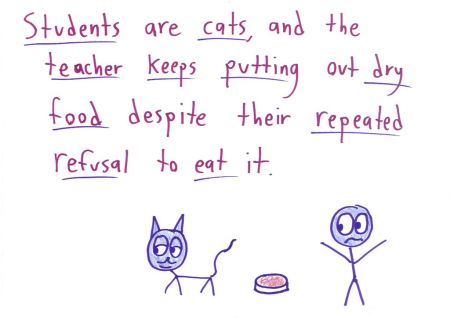Although much of the reason that I am in graduate school is for an eventual career teaching college students, I have not had many opportunities to teach courses yet. Therefore, for a teaching reflection, I will be reflecting on other opportunities I have had to speak and the one or two opportunities I have had to give a guest lecture.
For the purposes of this blog, I will consider two different experience I’ve had related to teaching: (1) in the fall, when I gave a guest lecture for my advisor in a sophomore-level dynamics course, and (2) yesterday, when I got the opportunity to preach the sermon at my church, Fieldstone UMC. There are actually a surprising amount of similarities between the two experiences. Note: my faith is very important to me, but this is a blog about teaching.
In reflecting on these two experiences, I’ve noticed some things about my teaching style.
Examples are very important to me
Examples help illustrate concepts and help us connect ideas to things we can already wrap our heads around. Maybe its the engineer in me, but I think that examples make incredibly powerful teaching tools.
In the dynamics course, I was teaching about the impulse-momentum equation

Which says that there’s this thing called the impulse,  , that is equal to the change in momentum. It is a useful formula for studying things like the dynamics of billiards and car accidents. To introduce the topic to my class, though, I didn’t just give them that equation, because equations are scary. I showed a video of a golf ball deforming and talked about how the impulse represents the total effect of that deformation and restoration. Therefore, we don’t have to know the details of that deformation. All we need to know is the change in velocity of the club head in order to determine the velocity that the ball.
, that is equal to the change in momentum. It is a useful formula for studying things like the dynamics of billiards and car accidents. To introduce the topic to my class, though, I didn’t just give them that equation, because equations are scary. I showed a video of a golf ball deforming and talked about how the impulse represents the total effect of that deformation and restoration. Therefore, we don’t have to know the details of that deformation. All we need to know is the change in velocity of the club head in order to determine the velocity that the ball.
In the sermon, I was discussing how small actions can have a profound impact, and I shared a TED talk by Drew Dudley entitled Everyday Leadership. He shares the amazing story about a time that he gave a lollipop to a girl and it utterly changed her life. Thinking about how this moment where he had so profoundly impacted somebody without even remembering it, we can see how we may all be able to impact those around us through small actions.
Examples people something tangible to hold onto when discussions become abstract.
I like to make people move
As we’ve discussed in class, lectures can get boring and people don’t have the attention span. I like to make people move around the room if possible to get the blood flowing and to help them engage.
In the dynamics course, I used a sort of think-pair-share to get the students to try to apply the knowledge in small groups and then discuss with the class in order to make sure that students were engaging with the material rather than just listening to me drone on. In a boring class talking about a derivation, I had the students try it first. Then, they would have something to go from when we talked about the material in class.
During the sermon, I was trying to encourage people to be more conscious of creating a welcoming environment. In the middle of the sermon, I asked everyone to stand up and learn the name of one other person in the room. The room was immediately filled with energy and the rest of the sermon flowed from that energy.
Getting people physically moving during a lecture helps them be involved.
It’s important to keep people engaged
Engagement is hard to describe when giving a presentation of any kind, but it is the most important thing. I think that engagement is just something you can feel. It’s in eye contact and facial expressions, but it’s really just something that you can feel.
I felt it while performing in musicals in high school. I felt it I spent my first couple years of graduate school giving presentations to prospective students and their parents. I felt it yesterday while preaching, and I felt it from some of the students when I taught the dynamics class.
I don’t yet know how to improve that engagement in the classroom. I think that is something that I’ll be working at throughout my career as a teacher.
What do you think? Do you have any fun examples to share? Do you have fun ideas to get people moving in the classroom? Do you know what it feels like when the audience is engaged? Why is it so much harder to be an engaging speaker in a classroom environment?


